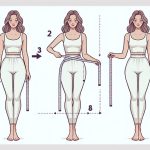When it comes to distinguishing waist from hips, it's like finding your way through a sartorial labyrinth – essential yet tricky.
I've always pondered the nuances of getting these measurements right; it's a puzzle that holds more significance than just numbers on a tape.
But how do you guarantee precision in these fundamental body metrics? Well, let's unravel the secrets of accurate waist and hip measurements together, shedding light on why this knowledge might be more impactful than you think.
Table of Contents
Key Takeaways
- Waist measurements crucial for assessing health risks like hypertension and diabetes.
- Hip measurements aid in understanding body shape and fat distribution.
- Calculating waist-to-hip ratio predicts heart disease likelihood.
- Proper tape measure placement essential for accurate health evaluations.
Importance of Accurate Measurements
Understanding the significance of obtaining precise measurements is fundamental to effectively evaluating one's health status and potential risks. When it comes to evaluating health risks such as hypertension, diabetes, and cardiovascular disease, accurate measurements of waist circumference and hip size play a crucial role. These measurements provide valuable insights into fat distribution and body shape, particularly for individuals with apple-shaped bodies who are at higher risk for various health issues.
Calculating the waist-to-hip ratio further enhances the ability to predict the likelihood of heart disease, making it a critical component of health evaluations. Recommended waist sizes below 35 inches for women and 40 inches for men have been established to help reduce the occurrence of health complications associated with excess abdominal fat.
Ensuring proper placement of the tape measure when measuring waist and hips is essential for obtaining reliable and informative data for evaluating overall health and well-being.
Waist Measurement Techniques
When measuring the waist accurately, start by identifying the natural waistline located between the hipbones and ribs. To make sure precise measurements, it's important to use a cloth tape measure on the skin's surface without applying any compression. Wearing tight clothing during the measurement process can also help in obtaining accurate results. For both men and women, maintaining a waist size of less than 35 inches for women and less than 40 inches for men is recommended to reduce health risks associated with increased waist circumference. This is vital as waist size is linked to health issues like hypertension, type 2 diabetes, and cardiovascular disease.
| Waist Measurement Techniques |
|---|
| Locate natural waistline between hipbones and ribs |
| Use cloth tape measure on skin's surface without compression |
| Wear tight clothing during measurement |
| Recommended waist size: < 35 inches for women, < 40 inches for men |
| Waist circumference linked to health risks like hypertension, diabetes, and cardiovascular diseases |
Hip Measurement Techniques
To accurately measure hips, one should locate the widest part of the buttocks and carefully wrap a cloth tape measure around without applying excessive pressure.
Hip measurements play a vital role in evaluating body shape and fat distribution, providing valuable insights into one's physique.
When measuring hips, it's important to wear tight clothing to guarantee a precise and snug fit, especially for determining clothing sizes that rely on hip circumference, such as pants and skirts.
Keeping the tape measure parallel to the ground while measuring the hips is key to obtaining consistent and accurate results for proper garment fitting.
Understanding your hip measurements can help you choose clothing that fits your torso well and enhances your overall look.
Calculating Waist-to-Hip Ratio
Calculating the waist-to-hip ratio involves dividing the waist measurement by the hip measurement. This ratio is essential for understanding body proportions and is a key factor in garment fitting.
For an ideal hourglass figure, aim for a ratio around 0.7; for a pear shape, approximately 0.8 is ideal, while a ratio of 0.9 suits a rectangular body shape.
By mastering accurate waist and hip measurement techniques, designers can create garments that enhance natural curves and flatter different body types. Adjusting patterns based on the waist-to-hip ratio helps achieve flattering silhouettes and makes sure that clothing fits well.
Whether you're designing for an hourglass, pear, or rectangle body shape, the waist-to-hip ratio is a valuable tool in creating clothing that complements the unique proportions of each individual.
Interpreting Health Significance
Understanding the health implications of waist and hip measurements is important for evaluating potential risks and overall well-being. When it comes to evaluating health risks, both waist and hip measurements play significant roles. The distribution of body fat, indicated by these measurements, can provide insights into the likelihood of developing conditions such as cardiovascular disease. Higher waist measurements above recommended thresholds are associated with increased health risks, particularly for hypertension, diabetes, and heart disease. On the other hand, hip measurements help in understanding body shape and fat distribution, with fat around the hips posing fewer health risks compared to fat around the waist. Calculating the waist-to-hip ratio further aids in predicting the risk of chronic conditions. Here is a table summarizing the key points:
| Measurement | Health Significance |
|---|---|
| Waist | Higher measurements increase risks for cardiovascular disease, hypertension, and diabetes. |
| Hip | Helps in understanding body shape and fat distribution. Fat around hips poses lower health risks. |
| Waist-to-Hip Ratio | Predicts the risk of heart disease and chronic conditions based on body fat distribution. |
Tips for Tracking Changes
For effective tracking of changes in waist and hip measurements, consistency in measurement techniques is key to ensuring accurate progress monitoring. To track changes effectively, consider the following tips:
- Track changes: Regularly monitor waist and hip measurements to stay informed about progress.
- Use consistent measurement techniques: Guarantee reliability and precision by measuring in the same way each time.
- Document measurements: Keep a journal or use an app to record measurements and track changes over time.
- Look for patterns in measurements: Identify trends to pinpoint areas of improvement or areas that may need more focus.
- Consider progress photos: Visualize changes alongside measurements to monitor progress and stay motivated.
Frequently Asked Questions
How Many Inches Bigger Should Your Hips Be Than Your Waist?
My hips should typically be a few inches larger than my waist to achieve a curvier silhouette. This ratio helps in creating an attractive figure and reducing health risks associated with excess abdominal fat.
How Do You Measure the Distance From Your Waist to Your Hip?
I measure the distance from my waist to my hip by locating my natural waistline and the widest part of my hips, then using a flexible cloth tape measure. Keeping it parallel to the floor guarantees precise measurements for body proportions and garment fitting.
What Is the Formula for Waist Hip Ratio?
To calculate waist-to-hip ratio, divide waist measurement by hip measurement. Ideal values are below 0.8 for women, 0.9 for men, as per WHO. Higher ratios indicate increased health risks. Monitoring and maintaining WHR is vital for reducing health complications.
What Is the Most Attractive Hip to Waist Ratio?
For me, the most attractive hip to waist ratio is typically around 0.7, creating that coveted hourglass shape. This ratio is linked to higher fertility and perceived beauty, making it a desirable feature across various cultures.
- Does Lyocell Shrink When Washed? A Complete Laundry Guide - July 14, 2025
- Is Lyocell Good for Summer? Why It’s a Top Warm-Weather Fabric - July 14, 2025
- Lyocell vs. Cotton Shrinkage: Which Fabric Shrinks More? - July 14, 2025




